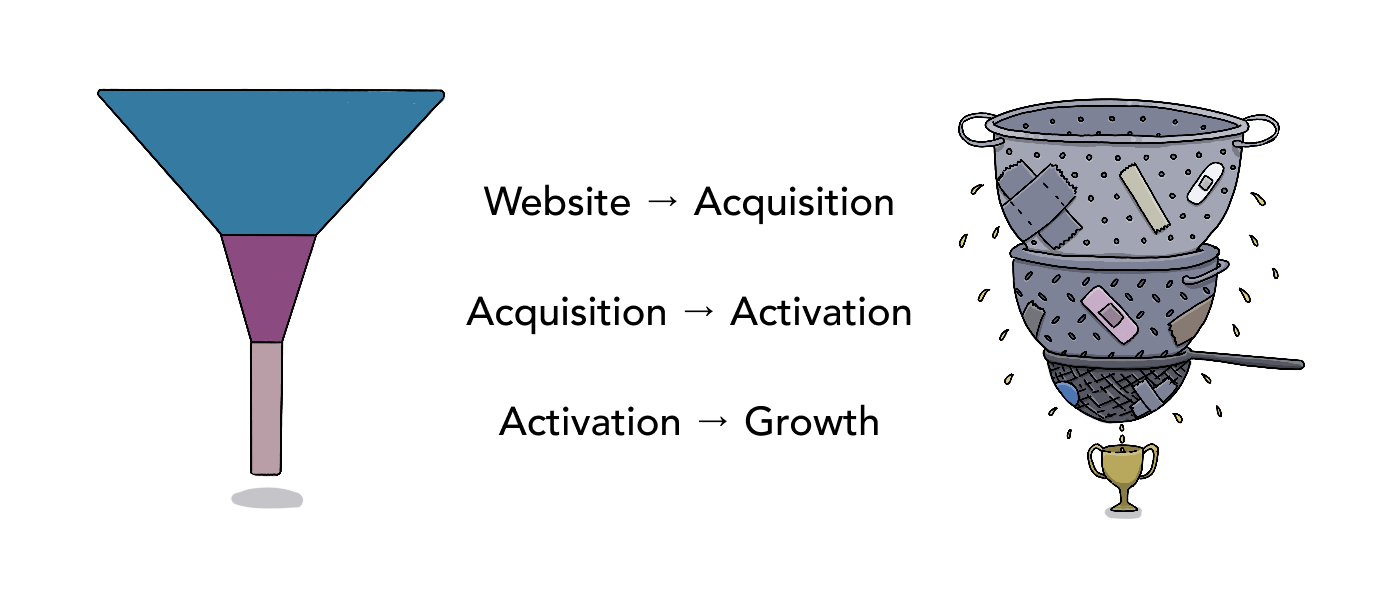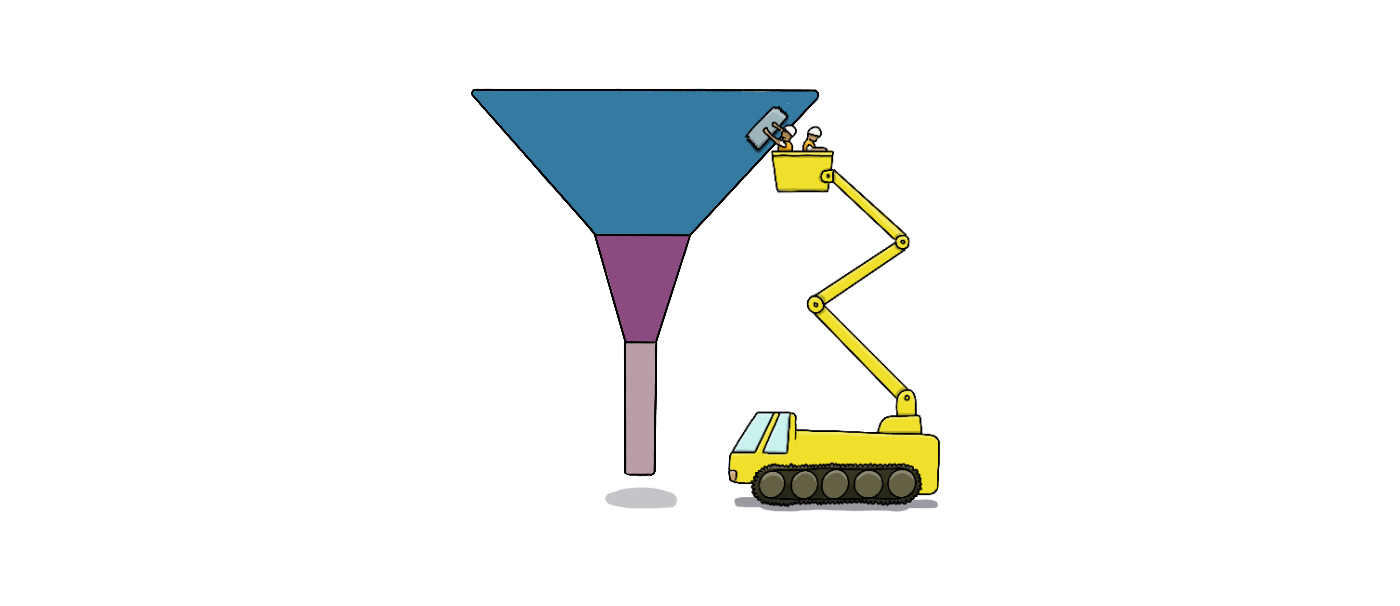Repair tips for leaky conversion funnels

This article was originally published on Medium.

You’re probably familiar with conversion funnel diagrams. They’re called funnels because of their shape, but they act more like a series of stacked colanders because as the contents flows through it, some drops out of the sides. Product Managers love these as a visualisation tool, and we use them to measure and illustrate flow and drop-off as visitors convert to users and then customers.
At the top of the funnel, we have visitors land on our website, and some sign up. This is usually where we see the most drop-off, as many visitors realise the product isn’t for them and go about their day. Then we have the middle of the funnel where users go from signing up to activating. At the bottom, we have users converting to customers as they start paying for the product.
Some leaks are good — it’s unrealistic to expect every visitor to your website to sign up and convert into a customer. Not every visitor is a good fit for your product, and not every user is in a position to pay for it. But the best way to reach your business goals is for those who are a good fit to stay in the funnel and move all the way down it. To do that, you’ll need to identify where your most critical leaks are, and then repair these areas. These might not necessarily be the biggest leaks, but the ones where your ideal users are flowing out.
 Leaky top
Leaky top
As mentioned, a leaky top isn’t necessarily a bad thing. You might be getting a tonne of traffic, with visitors who are a bad fit naturally disqualifying.

There are two things we need to do at this stage — first, ensure the right leads visit in the first place, and secondly ensure that those leads end up converting.
 Leaky top repair tips
Leaky top repair tips
- Check website performance
If you’re seeing high bounce rates, this is commonly a symptom of poor website performance. Tools such as Lighthouse will run a quick check on your marketing site to validate whether performance is causing users to leave prematurely, and offer advice on how to improve it. - Validate your messaging with your ideal user
Low signups might be an indication that your website’s marketing messaging isn’t landing right, so get feedback from potential users on what they’re responding well to, or run some A/B tests to try out different messaging. Make sure you’re communicating the value rather than just features, which, I’ve recently written a post on. - Identify the best sources for conversion
Most analytics tools have a way of visualising conversion based on source, and you can use those findings to focus your marketing efforts. If you’re using Amplitude, you can map this using their Pathfinder tool. PostHog has Path Analysis, and Google Analytics has Path Exploration. Start by looking at the sources of visitors, which of those are leading to the highest conversion, and which have a low chance of conversion. Lean into the places that are sending you high quality leads. - Review drop-off at each stage of the signup flow
Map each stage of your signup flow and identify where the largest percentage of drop-offs are. This is a good place to do some quick usability testing, and can be a great onboarding exercise — have each new employee record a video of them signing up for an account and talking aloud about their first impressions and where they got stuck. - Turn dead ends into cul-de-sacs
A common dead end in signup flows is where a user needs to request permission from their admin to continue setting up an integration. Inevitably, the admin will receive a generic integration request with very little context about what the tool is, and will likely decline it. There are a couple of things you can do here. First, help the user vouch for the product, such as by letting them send a personalised note to the admin with information about how this tool will help them. The second is to allow the user to proceed with signup without the integration, ideally letting them try out the product with example data while they wait for approval. This will help later with activation — more about that next.
 Leaky middle
Leaky middle
If you’re happy with the number of sign ups but your activation rate is low, you’ve got a leaky middle. It’s good to address this before investing further in marketing so those new acquisitions aren’t falling straight out of the funnel.

Activation is the point at which a user first experiences the real value of your product, and this is unique for each product. For example, Zapier’s is when a user sets up a Zap. If you’re a collaborative product, the activation point should be some form of collaboration. Loom’s is when a user shares a Loom with someone else. Figma’s is when a user performs an activity in someone else’s file. Some activation points are pretty elaborate — Slack’s is when a team or more than two users post 50+ messages within the first 7 days.
Appcues have a couple of handy articles on this, including how to identify your activation point and an aha moment optimisation guide. Also, Lenny Rachitsky has a whole thread on activation metrics, which is where I gathered those examples from.
 Leaky middle repair tips
Leaky middle repair tips
- Reduce the number of options at signup
Tools like OAuth give us the option to offer our users many different auth methods to sign up, but some options may lead to much lower conversion than others. For example, if you’ve built a Slack plugin and you let users auth with Google, they’re going to have to go through an extra step to auth with Slack anyway. You might end up with users who don’t even have a Slack account so aren’t eligible to convert. There may be a good reason to present other options, such as to support Enterprises who require different login methods, but outside of this, you should be pushing users down the path that will have the biggest chance of them successfully activating. - Defrost cold starts
Cold starts are where the user is presented with an empty workspace once they sign up, and this presents a hurdle for activation. Entire books have been written about this issue. This is common in social products where a user needs to add others to see content, and in dev tools where a process needs to run or an integration needs to be set up first, and reporting tools where data needs to be populated over time. Many apps tackle this with pre-populated “sandbox” experiences where users can play around without affecting any production data. They can review the full functionality of the product’s reports without having to wait months for theirs to populate and start to see trends.
 Leaky bottom
Leaky bottom
You’ve got users to sign up and activate, but that’s just half of the journey! The most critical part of the funnel in terms of validating your product and making revenue is at the bottom.

I’ve grouped together activities like growth, retention and upgrades here — essentially what turns a user into a customer, or at least an active user, but if you’re in customer success or post-sales, this part of the funnel should be broken down further.
If retention is very low, this could be a symptom of poor product market fit. You’ll need to rule that out first, otherwise any efforts to improve conversion will probably fail. In his 12th edition of Minute Monday, Ben Williams lists 3 main reasons for poor retention:
- The product doesn’t have enough value for users in the market to want to return
- The product isn’t doing a good enough job of connecting users to value
- You’re acquiring a disproportionately high number of bad-fit users
If you’re confident that number 1 is not the issue, here are some ways you can address 2 and 3.
 Leaky bottom repair tips
Leaky bottom repair tips
- Incentivise retention, not acquisition
Ben’s 3rd item is usually down to a mismatch between marketing and product. This is where proper incentives are important. Have your marketing team accountable for the bottom of the funnel as well as the top. If they’re incentivised purely on getting more visitors to sign up, it becomes tempting to make the messaging less targeted just to get people through the door, causing your conversion rates further down to dive. - Identify and encourage top retention events
Earlier on, I mentioned conversion visualisation tools. This is a great place to use them again to identify what actions lead to higher conversion. And if you’re using a tool like Amplitude, you can build Retention Analysis charts to identify which events are likely to have an impact on retention. For example, a product I was reviewing had a much higher chance of retention if a user created a specific type of project, indicating that users were finding the value at this point. As a result, we changed the activation point to this and made it part of the onboarding flow. - Help users form habits
Good retention means users are regularly using your product. For products that embed into a user’s existing process, such as CI tools, this happens passively. But some products need more of a nudge to get users to return. This is where a product usage report email may help to remind the user of the value your product offers. - Offer collaboration incentives for collaborative products
A common cause of low retention is where a collaborative product is designed with a single player flow. This is often because the product owner doesn’t realise that their product’s value is in collaboration, so doesn’t incentivise users for inviting others. Not sure? Look at the average retention rate of users who invited other users. If it’s a lot higher, that indicates your product is giving users more value as a multi-player experience. If it’s roughly the same, it’s probably single player. If you’re a collaborative product, you’ll need to do your best to encourage individuals to invite their team. Airtable do this by applying one-off credits to future plan payments for each user invited, encouraging users to invite more of their team. - Make upgrades compelling
If you offer a freemium version of your product and users are retaining but not converting to a paid plan, you might be making it too easy to stay on the free plan. Revisit your freemium strategy and consider adjusting it to make it more likely for users to hit their limits, making an upgrade more compelling. Using Airtable’s credits example again, by performing “good” activity, the reward is a lower initial jump from a free to paid plan, making it more palatable to upgrade. This referral scheme benefits Airtable in the long term, as the more users invited to a workspace, the higher the retention rate and the more likely the account is to grow.
 Funnel repair checklist
Funnel repair checklist
There are of course many more ways to repair leaks in a conversion funnel than I’ve managed to fit into this post. Hopefully these will help you plug some of the most critical ones. To summarise:
- If your post-signup conversion is bad, pause on marketing and fix those leaks first so you’re not filling a bucket full of holes. But before you do that, consider whether it’s due to a lack of product market fit.
- If your post-signup conversion rates are great, that’s a signal to push more on marketing to increase the number of users in the funnel.
- Monitor your website and app’s loading times using a tool such as Lighthouse to ensure drop-off isn’t caused by performance frustration.
- Ensure your marketing is attracting the right audience, so you don’t end up with lots of drop-off due to poor fit.
- Look at where your visitors coming from and which sources lead to the highest conversion.
- Map your signup flow drop-off and focus on improvements to the areas where drop-off is highest to keep users moving through it. If a big drop-off point is due to integration permissions, personalise the request flow to make approval more likely, and give users a way to try the product while they wait.
- Make the onboarding path that’s most likely to lead to acquisition the most prominent.
- Avoid presenting users with a completely blank slate. Give them a way of seeing what the value will be once their workspace is fully populated.
- Ensure your marketing team’s incentives are not purely on acquisition, as this will reduce your conversion rates as your funnel gets filled with poor-fit users.
- Monitor the events that are most likely to lead to retention, and encourage these actions.
- Be proactive about giving users a reason to return.
- If your product’s value is in collaboration, do everything in your power to encourage users to invite others.
- Review your freemium/free plan strategy to ensure the upgrade path is compelling enough. It should balance the ability for users to see the value of the tool with the pain of hitting limits or losing access to features they found useful.